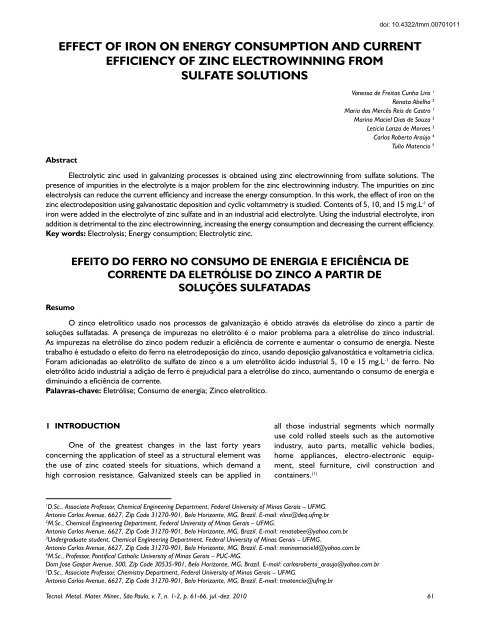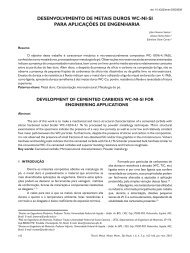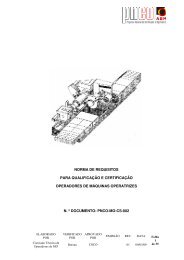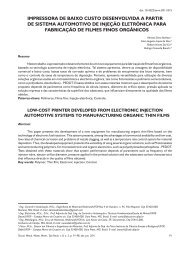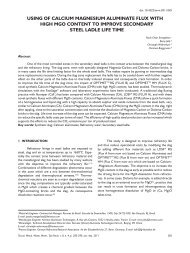EffEct of iron on EnErGY conSUMPtion AnD cUrrEnt ... - ABM
EffEct of iron on EnErGY conSUMPtion AnD cUrrEnt ... - ABM
EffEct of iron on EnErGY conSUMPtion AnD cUrrEnt ... - ABM
Create successful ePaper yourself
Turn your PDF publications into a flip-book with our unique Google optimized e-Paper software.
One method <str<strong>on</strong>g>of</str<strong>on</strong>g> producti<strong>on</strong> <str<strong>on</strong>g>of</str<strong>on</strong>g> electrolytic zinc is electrowinningusing sulfate soluti<strong>on</strong>s. The depositi<strong>on</strong> <str<strong>on</strong>g>of</str<strong>on</strong>g> electrolytic zincfrom alkaline zincate soluti<strong>on</strong> was investigated recently. (2,3) Currentis applied through insoluble electrodes and causes zinc depositi<strong>on</strong><strong>on</strong> cathode. Several parameters affect zinc electrolysis and itsc<strong>on</strong>trol. (4) The presence <str<strong>on</strong>g>of</str<strong>on</strong>g> impurities in the electrolyte is a majorproblem for the zinc electrowinning industry. (5) The synergisticinteracti<strong>on</strong>s am<strong>on</strong>g impurities determine the quality <str<strong>on</strong>g>of</str<strong>on</strong>g> zinc depositfrom the soluti<strong>on</strong>. (6)Literature about the effect <str<strong>on</strong>g>of</str<strong>on</strong>g> impurities <strong>on</strong> zinc electrowinningis still scarce and restrict to specific impurities such asantim<strong>on</strong>y, (7) nickel, (8) cadmium, <str<strong>on</strong>g>ir<strong>on</strong></str<strong>on</strong>g> and copper. (5)A promising development in this area is the applicati<strong>on</strong> <str<strong>on</strong>g>of</str<strong>on</strong>g>cyclic voltammetry and <str<strong>on</strong>g>of</str<strong>on</strong>g> electrochemical impedance spectroscopyto the investigati<strong>on</strong> <str<strong>on</strong>g>of</str<strong>on</strong>g> the electrodepositi<strong>on</strong> process. (5,9)The aim <str<strong>on</strong>g>of</str<strong>on</strong>g> this work is to study the effect <str<strong>on</strong>g>of</str<strong>on</strong>g> <str<strong>on</strong>g>ir<strong>on</strong></str<strong>on</strong>g> in the zincelectrowinning process using electrochemical techniques such asgalvanostatic depositi<strong>on</strong> and cyclic voltammetry. Two electrolyteswere studied: a zinc sulfate electrolyte, pH 5.05, and an acid industrialelectrolyte <str<strong>on</strong>g>of</str<strong>on</strong>g> zinc sulfate with additi<strong>on</strong> <str<strong>on</strong>g>of</str<strong>on</strong>g> 180 g.L -1 <str<strong>on</strong>g>of</str<strong>on</strong>g> H 2SO 4.2 MATERIALS AND METHODSTwo electrolytes <str<strong>on</strong>g>of</str<strong>on</strong>g> zinc sulfate were used. A soluti<strong>on</strong> <str<strong>on</strong>g>of</str<strong>on</strong>g>60 g.L -1 <str<strong>on</strong>g>of</str<strong>on</strong>g> zinc was prepared dissolving 262.8 g <str<strong>on</strong>g>of</str<strong>on</strong>g> ZnSO 4.7H 2O in1000 mL <str<strong>on</strong>g>of</str<strong>on</strong>g> dei<strong>on</strong>ized water. Soluti<strong>on</strong>s c<strong>on</strong>taining 60 g.L -1 <str<strong>on</strong>g>of</str<strong>on</strong>g> zincand 5, 10, and 15 mg.L -1 <str<strong>on</strong>g>of</str<strong>on</strong>g> <str<strong>on</strong>g>ir<strong>on</strong></str<strong>on</strong>g> were prepared using ZnSO 4.7H 2O,FeSO4.7H 2O, and dei<strong>on</strong>ized water.Ir<strong>on</strong> was added in a sec<strong>on</strong>d electrolyte, used in an industrialplant <str<strong>on</strong>g>of</str<strong>on</strong>g> zinc electrowinning. Chemical characterizati<strong>on</strong> <str<strong>on</strong>g>of</str<strong>on</strong>g> thisindustrial acid electrolyte is shown in Table 1. Chemical analysiswas performed using the technique <str<strong>on</strong>g>of</str<strong>on</strong>g> atomic absorpti<strong>on</strong> spectrophotometry.C<strong>on</strong>tents <str<strong>on</strong>g>of</str<strong>on</strong>g> 5 mg.L -1 , 10 mg.L -1 , and 15 mg.L -1 wereadded in the industrial electrolyte.Table 1. Chemical compositi<strong>on</strong> <str<strong>on</strong>g>of</str<strong>on</strong>g> the industrial electrolyteElement C<strong>on</strong>tent (g.L -1 )Zn 51.59Fe 8.06.10 -4Mn 1.36Mg 7.27Cd 0.06Electrochemical tests <str<strong>on</strong>g>of</str<strong>on</strong>g> galvanostatic depositi<strong>on</strong> using apotentiostat/galvanostat AUTOLAB PGSTAT 30 were performed.Electrochemical cell was <str<strong>on</strong>g>of</str<strong>on</strong>g> three electrodes, an anode <str<strong>on</strong>g>of</str<strong>on</strong>g> Pb-Ag(1% wt), a cathode <str<strong>on</strong>g>of</str<strong>on</strong>g> aluminum and the reference electrode wasAg/AgCl. Zinc was deposited using galvanostatic depositi<strong>on</strong>, applyinga current density <str<strong>on</strong>g>of</str<strong>on</strong>g> 500 A.m -2 , which is used in the industrial plant <str<strong>on</strong>g>of</str<strong>on</strong>g>zinc electrolysis. A depositi<strong>on</strong> time <str<strong>on</strong>g>of</str<strong>on</strong>g> 3 hours was used. Superficialarea <str<strong>on</strong>g>of</str<strong>on</strong>g> cathode and anode was 1.0 cm 2 . Before testing, cathodeswere polished with 600-mesh sandpaper, washed in distilled waterand dried. The zinc was removed from the cathode surface with astainless steel spatula. Zinc deposits were weighedin a precisi<strong>on</strong> balance for measurements <str<strong>on</strong>g>of</str<strong>on</strong>g>0.0001 g. The aluminum cathode was also weighedbefore and after depositi<strong>on</strong> (with the zinc deposits).Each experiment was performed five times.Anders<strong>on</strong>-Darling normality analysis wasperformed to verify if the obtained data <str<strong>on</strong>g>of</str<strong>on</strong>g> depositedzinc mass have a normal distributi<strong>on</strong>. F test<str<strong>on</strong>g>of</str<strong>on</strong>g> variance analysis (Minitab s<str<strong>on</strong>g>of</str<strong>on</strong>g>tware, versi<strong>on</strong> 15)was used to verify the equality <str<strong>on</strong>g>of</str<strong>on</strong>g> media. ApplyingFaraday law, the theoretical mass <str<strong>on</strong>g>of</str<strong>on</strong>g> zinc wascalculated using the equati<strong>on</strong>: (10)dnidQI = nF =(1)dt dtwhere I is the electric current, in amperes, n isthe moles <str<strong>on</strong>g>of</str<strong>on</strong>g> electr<strong>on</strong>s, F is the Faraday c<strong>on</strong>stant,dni/dt represents the rate <str<strong>on</strong>g>of</str<strong>on</strong>g> reacti<strong>on</strong> in moles persec<strong>on</strong>d, Q is the quantity <str<strong>on</strong>g>of</str<strong>on</strong>g> electricity or chargein coulombs (C), and t is the time. The theoreticalzinc mass calculated was 184.71 mg. The currentefficiency can be expressed by the ratio <str<strong>on</strong>g>of</str<strong>on</strong>g> depositedzinc mass and theoretical zinc mass.Energy c<strong>on</strong>sumpti<strong>on</strong> (kWh/t<strong>on</strong>) was calculatedusing the expressi<strong>on</strong>:5Vm.8.4.10(2)10.CEwhere Vm is the average potential (V), and CE thecurrent efficiency (%).Cyclic voltammetry tests were performedusing a potentiostat/galvanostat AUTOLABPGSTAT 30. Electrochemical cell was <str<strong>on</strong>g>of</str<strong>on</strong>g> threeelectrodes: an anode <str<strong>on</strong>g>of</str<strong>on</strong>g> aluminum, a counter electrode<str<strong>on</strong>g>of</str<strong>on</strong>g> platinum and the reference electrodewas Ag/AgCl. Superficial area <str<strong>on</strong>g>of</str<strong>on</strong>g> cathode andanode was 1 cm 2 . The scan rate was 10 mV.s -1 ,and the potential range was from 0 to –1600 mV.Characterizati<strong>on</strong> <str<strong>on</strong>g>of</str<strong>on</strong>g> the electrodepositedzinc was performed using scanning electr<strong>on</strong>microscopy (SEM), and energy dispersive spectroscopy(EDS). Image analysis using Quantikov (11)s<str<strong>on</strong>g>of</str<strong>on</strong>g>tware was carried out to evaluate porosity <str<strong>on</strong>g>of</str<strong>on</strong>g>the deposit.3 RESULTS AND DISCUSSION3.1 Current Efficiency and EnergyC<strong>on</strong>sumpti<strong>on</strong>3.1.1 Electrolyte <str<strong>on</strong>g>of</str<strong>on</strong>g> acid soluti<strong>on</strong>Table 2 shows current efficiency andenergy c<strong>on</strong>sumpti<strong>on</strong> obtained in acid electrolyteswithout Fe and with additi<strong>on</strong>s <str<strong>on</strong>g>of</str<strong>on</strong>g> 5 mg.L -1 ,10 mg.L -1 , and 15 mg.L -1 <str<strong>on</strong>g>of</str<strong>on</strong>g> Fe.62 Tecnol. Metal. Mater. Miner., São Paulo, v. 7, n. 1-2, p. 61-66, jul.-dez. 2010
Table 2. Current efficiency and energy c<strong>on</strong>sumpti<strong>on</strong> <str<strong>on</strong>g>of</str<strong>on</strong>g> zinc electrowinning from acid soluti<strong>on</strong>Acid electrolyte Cell voltage(mV Ag/AgCl)Electrodepositedzinc mass(mg)Theoreticalzinc mass(mg)Currentefficiency(%)Energyc<strong>on</strong>sumpti<strong>on</strong>(kWh/T)Without Fe 1826 ± 4 654.8 ± 1.2 728 89.9 1705Additi<strong>on</strong> <str<strong>on</strong>g>of</str<strong>on</strong>g> 5 mg.L -1 <str<strong>on</strong>g>of</str<strong>on</strong>g> Fe 1835 ± 5 638.4 ± 0.9 728 87.7 1758Additi<strong>on</strong> <str<strong>on</strong>g>of</str<strong>on</strong>g> 10 mg.L -1 <str<strong>on</strong>g>of</str<strong>on</strong>g> Fe 1864 ± 5 641.5 ± 0.6 728 88.1 1777Additi<strong>on</strong> <str<strong>on</strong>g>of</str<strong>on</strong>g> 15 mg.L -1 <str<strong>on</strong>g>of</str<strong>on</strong>g> Fe 1896 ± 3 640.9 ± 0.6 728 88.0 1810Ir<strong>on</strong> additi<strong>on</strong> is detrimental to the zinc electrowinning,increasing the energy c<strong>on</strong>sumpti<strong>on</strong> and decreasing the currentefficiency. Am<strong>on</strong>g the soluti<strong>on</strong>s with <str<strong>on</strong>g>ir<strong>on</strong></str<strong>on</strong>g> additi<strong>on</strong>, the additi<strong>on</strong> <str<strong>on</strong>g>of</str<strong>on</strong>g>10 mg.L -1 produces the highest current efficiency.3.1.2 Electrolyte <str<strong>on</strong>g>of</str<strong>on</strong>g> zinc sulfateThe additi<strong>on</strong> <str<strong>on</strong>g>of</str<strong>on</strong>g> <str<strong>on</strong>g>ir<strong>on</strong></str<strong>on</strong>g> in the zinc sulfate electrolyte did notchange the zinc mass deposited <strong>on</strong> cathode, and did not change thecurrent efficiency, as shown in Table 3.Table 3. Current efficiency and energy c<strong>on</strong>sumpti<strong>on</strong> <str<strong>on</strong>g>of</str<strong>on</strong>g> zinc electrowinningfrom zinc sulfate soluti<strong>on</strong>Zinc sulfateelectrolyteCell voltage(mV Ag/AgCl)Electrodepositedzinc mass(mg)Theoreticalzinc mass(mg)Current Energyefficiency c<strong>on</strong>sumpti<strong>on</strong>(%) (kWh/T)Without Fe 2069 ± 3 182.4 ± 1.4 183 99.6 1744Additi<strong>on</strong> <str<strong>on</strong>g>of</str<strong>on</strong>g>5 mg/L <str<strong>on</strong>g>of</str<strong>on</strong>g> Fe2038 ± 4 182.1 ± 0.8 183 99.4 1722Additi<strong>on</strong> <str<strong>on</strong>g>of</str<strong>on</strong>g>10 mg/L <str<strong>on</strong>g>of</str<strong>on</strong>g> Fe2094 ± 5 182.5 ± 0.7 183 99.7 1765Additi<strong>on</strong> <str<strong>on</strong>g>of</str<strong>on</strong>g>15 mg/L <str<strong>on</strong>g>of</str<strong>on</strong>g> Fe2105 ± 5 182.1 ± 1.8 183 99.4 1778The additi<strong>on</strong> <str<strong>on</strong>g>of</str<strong>on</strong>g> 5 mg.L -1 <str<strong>on</strong>g>of</str<strong>on</strong>g> Fe decreases the energyc<strong>on</strong>sumpti<strong>on</strong> and the additi<strong>on</strong> <str<strong>on</strong>g>of</str<strong>on</strong>g> 10, and 15 mg/L <str<strong>on</strong>g>of</str<strong>on</strong>g> Fe increasesenergy c<strong>on</strong>sumpti<strong>on</strong> (Table 3).The current efficiency obtained using the electrolyte <str<strong>on</strong>g>of</str<strong>on</strong>g> zincsulfate without H 2SO 4additi<strong>on</strong>, which is in the range <str<strong>on</strong>g>of</str<strong>on</strong>g> 99.5%,is higher than the current efficiency observed using the acid electrolyte,which was between 87.7% and 89.9%. For the electrolyte<str<strong>on</strong>g>of</str<strong>on</strong>g> zinc sulfate, the hydrogen reducti<strong>on</strong> reacti<strong>on</strong> did not competesignificantly with zinc reducti<strong>on</strong>. Over potential <str<strong>on</strong>g>of</str<strong>on</strong>g> zinc cathodeincreases with a decrease <str<strong>on</strong>g>of</str<strong>on</strong>g> pH.3.2 Cyclic Voltammetry3.2.1 Electrolyte <str<strong>on</strong>g>of</str<strong>on</strong>g> acid soluti<strong>on</strong>Cyclic voltammetry experiments <str<strong>on</strong>g>of</str<strong>on</strong>g> zinc electrodepositi<strong>on</strong>from 51.6 g.L -1 Zn, and 180 g.L -1 <str<strong>on</strong>g>of</str<strong>on</strong>g> H 2SO 4soluti<strong>on</strong> <strong>on</strong> aluminumsubstrate were carried out. The cathodic potential was varied inthe range <str<strong>on</strong>g>of</str<strong>on</strong>g> 0 to –1600 mV (Ag/AgCl). The linear sweep curvesthat represent the <strong>on</strong>set <str<strong>on</strong>g>of</str<strong>on</strong>g> cathodic depositi<strong>on</strong> and redissoluti<strong>on</strong><str<strong>on</strong>g>of</str<strong>on</strong>g> deposited zinc are shown in Figure 1 for the soluti<strong>on</strong> without<str<strong>on</strong>g>ir<strong>on</strong></str<strong>on</strong>g> and with additi<strong>on</strong> <str<strong>on</strong>g>of</str<strong>on</strong>g> 5 mg.L -1 , 10 mg.L -1 and 15 mg.L -1 <str<strong>on</strong>g>of</str<strong>on</strong>g> Fe.Figure 1. Linear sweep curves that represent the <strong>on</strong>set <str<strong>on</strong>g>of</str<strong>on</strong>g>cathodic depositi<strong>on</strong> and redissoluti<strong>on</strong> <str<strong>on</strong>g>of</str<strong>on</strong>g> deposited zinc areshown for the acid soluti<strong>on</strong> without <str<strong>on</strong>g>ir<strong>on</strong></str<strong>on</strong>g> additi<strong>on</strong> and with5 mg.L -1 , 10 mg.L -1 and 15 mg.L -1 <str<strong>on</strong>g>of</str<strong>on</strong>g> Fe.The results are in good agreement withthe results <str<strong>on</strong>g>of</str<strong>on</strong>g> galvanostatic depositi<strong>on</strong>.The cathodic curve can be attributedto the zinc depositi<strong>on</strong> and hydrogen evoluti<strong>on</strong>reacti<strong>on</strong>s. Zinc depositi<strong>on</strong> started at –1050 mV(Ag/AgCl). The anodic curves corresp<strong>on</strong>d to thedissoluti<strong>on</strong> <str<strong>on</strong>g>of</str<strong>on</strong>g> the deposited zinc. The current <str<strong>on</strong>g>of</str<strong>on</strong>g>anodic peak is higher for the electrolyte without<str<strong>on</strong>g>ir<strong>on</strong></str<strong>on</strong>g> and for the electrolyte with 10 mg.L -1 <str<strong>on</strong>g>of</str<strong>on</strong>g> Fe,which also produced higher zinc mass electrodepositedin the galvanostatic depositi<strong>on</strong> than thesoluti<strong>on</strong>s with 5 and 15 mg.L -1 <str<strong>on</strong>g>of</str<strong>on</strong>g> <str<strong>on</strong>g>ir<strong>on</strong></str<strong>on</strong>g> as shownin Table 2. The electrolytes without <str<strong>on</strong>g>ir<strong>on</strong></str<strong>on</strong>g> and theelectrolyte with 10 mg.L -1 <str<strong>on</strong>g>of</str<strong>on</strong>g> Fe showed anodicpeaks at a higher potentials than the peaks forelectrolytes with 5, and 15 mg.L -1 <str<strong>on</strong>g>of</str<strong>on</strong>g> Fe. For ahigher zinc mass dissoluti<strong>on</strong>, a higher currentdensity and higher potentials were necessary.The two points <str<strong>on</strong>g>of</str<strong>on</strong>g> intercepti<strong>on</strong> <str<strong>on</strong>g>of</str<strong>on</strong>g> curves withaxis <str<strong>on</strong>g>of</str<strong>on</strong>g> abscise (zero current) determine thesegment <str<strong>on</strong>g>of</str<strong>on</strong>g> the nucleati<strong>on</strong> hysteresis loop. Thissegment is called BC.No peak corresp<strong>on</strong>ding to Fe depositi<strong>on</strong>is observed, probably because Fe does notadhere to the aluminum substrate and it is physicallyflushed away from the electrode surface byhydrogen evoluti<strong>on</strong>.Tecnol. Metal. Mater. Miner., São Paulo, v. 7, n. 1-2, p. 61-66, jul.-dez. 2010 63
Figure 1 shows that for the acid electrolyte without <str<strong>on</strong>g>ir<strong>on</strong></str<strong>on</strong>g>,the BC porti<strong>on</strong> decreases, indicating an accelerati<strong>on</strong> <str<strong>on</strong>g>of</str<strong>on</strong>g> thecathodic process. In the presence <str<strong>on</strong>g>of</str<strong>on</strong>g> Fe, the nucleati<strong>on</strong>/electrocrystallizati<strong>on</strong>overpotential (BC porti<strong>on</strong>) increases, meaning thatzinc depositi<strong>on</strong> becomes more difficult in the presence <str<strong>on</strong>g>of</str<strong>on</strong>g> Fe. Theadditi<strong>on</strong> <str<strong>on</strong>g>of</str<strong>on</strong>g> <str<strong>on</strong>g>ir<strong>on</strong></str<strong>on</strong>g> to the acid electrolyte produces an inhibiti<strong>on</strong> <str<strong>on</strong>g>of</str<strong>on</strong>g>the zinc depositi<strong>on</strong>, which can be c<strong>on</strong>firmed by the results <str<strong>on</strong>g>of</str<strong>on</strong>g> electrodepositedzinc mass as shown in Table 2. The inhibiti<strong>on</strong> <str<strong>on</strong>g>of</str<strong>on</strong>g> zincreducti<strong>on</strong> is due to the reducti<strong>on</strong> <str<strong>on</strong>g>of</str<strong>on</strong>g> ferric i<strong>on</strong>s, which is moresignificant as the <str<strong>on</strong>g>ir<strong>on</strong></str<strong>on</strong>g> c<strong>on</strong>tent increases. The ferric i<strong>on</strong>s wereattracted to cathode and competed with zinc i<strong>on</strong>s in the reducti<strong>on</strong>process.3.3 Morphology3.3.1 Acid electrolyteMorphology <str<strong>on</strong>g>of</str<strong>on</strong>g> electrodeposited zinc usingacid electrolyte shows hexag<strong>on</strong>al crystals <str<strong>on</strong>g>of</str<strong>on</strong>g> zinc,deposited as multilayer, as shown in Figure 3,which presents a micrograph <str<strong>on</strong>g>of</str<strong>on</strong>g> surface <str<strong>on</strong>g>of</str<strong>on</strong>g> electrodepositedzinc using an acid electrolyte with15 mg.L -1 Fe.3.2.2 Electrolyte <str<strong>on</strong>g>of</str<strong>on</strong>g> zinc sulfateThe linear sweep curves that represent cathodic and anodicreacti<strong>on</strong>s for the zinc sulfate electrolyte are shown in Figure 2.The electrolyte without <str<strong>on</strong>g>ir<strong>on</strong></str<strong>on</strong>g> additi<strong>on</strong> shows a lowestcurrent density <str<strong>on</strong>g>of</str<strong>on</strong>g> anodic peak. In this case, the zinc mass electrodepositedfrom an electrolyte without <str<strong>on</strong>g>ir<strong>on</strong></str<strong>on</strong>g> additi<strong>on</strong> was thesame mass deposited from an electrolyte with <str<strong>on</strong>g>ir<strong>on</strong></str<strong>on</strong>g> additi<strong>on</strong>. Atendency <str<strong>on</strong>g>of</str<strong>on</strong>g> formati<strong>on</strong> <str<strong>on</strong>g>of</str<strong>on</strong>g> a new anodic peak is observed at –50 mV(Ag/AgCl), and can be associated to the <str<strong>on</strong>g>ir<strong>on</strong></str<strong>on</strong>g> dissoluti<strong>on</strong> accordingto EDS results. The EDS analysis <str<strong>on</strong>g>of</str<strong>on</strong>g> the electrodeposited zincshows the presence <str<strong>on</strong>g>of</str<strong>on</strong>g> <str<strong>on</strong>g>ir<strong>on</strong></str<strong>on</strong>g> in deposited zinc, for the electrolysisusing the zinc sulfate with 10 and 15 mg.L -1 Fe.Figure 3. Micrograph <str<strong>on</strong>g>of</str<strong>on</strong>g> surface <str<strong>on</strong>g>of</str<strong>on</strong>g> electrodeposited zincusing an acid electrolyte with 15 mg.L -1 Fe.EDS analysis <str<strong>on</strong>g>of</str<strong>on</strong>g> the electrodeposited zincshows the presence <str<strong>on</strong>g>of</str<strong>on</strong>g> <str<strong>on</strong>g>ir<strong>on</strong></str<strong>on</strong>g> <strong>on</strong> deposited zincusing the acid electrolyte without <str<strong>on</strong>g>ir<strong>on</strong></str<strong>on</strong>g> additi<strong>on</strong>(0.25 wt% Fe), and with 10 mg.L -1 Fe additi<strong>on</strong>(0.11 wt% Fe). The acid industrial electrolytec<strong>on</strong>tained <str<strong>on</strong>g>ir<strong>on</strong></str<strong>on</strong>g> as impurity before <str<strong>on</strong>g>ir<strong>on</strong></str<strong>on</strong>g> additi<strong>on</strong>,according to Table 1. The electrodeposited zincusing the acid electrolyte without <str<strong>on</strong>g>ir<strong>on</strong></str<strong>on</strong>g> additi<strong>on</strong>showed a higher mass than the deposited zincobtained with acid electrolyte with additi<strong>on</strong> <str<strong>on</strong>g>of</str<strong>on</strong>g>5 and 15 mg.L -1 Fe.The porosity <str<strong>on</strong>g>of</str<strong>on</strong>g> electrodeposited zincdoes not change, or decreases with <str<strong>on</strong>g>ir<strong>on</strong></str<strong>on</strong>g> additi<strong>on</strong>in acid electrolyte as shown in Table 4.Figure 2. Linear sweep curves that represents the <strong>on</strong>set <str<strong>on</strong>g>of</str<strong>on</strong>g> cathodic depositi<strong>on</strong>and redissoluti<strong>on</strong> <str<strong>on</strong>g>of</str<strong>on</strong>g> deposited zinc are shown for the zinc sulfate soluti<strong>on</strong>without <str<strong>on</strong>g>ir<strong>on</strong></str<strong>on</strong>g> additi<strong>on</strong> and with 5 mg.L -1 , 10 mg.L -1 and 15 mg.L -1 Fe.The BC regi<strong>on</strong>s in the voltammograms shown in Figure 2 aresimilar in length, indicating a same facility <str<strong>on</strong>g>of</str<strong>on</strong>g> the cathodic process.The values <str<strong>on</strong>g>of</str<strong>on</strong>g> electrodeposited zinc mass <str<strong>on</strong>g>of</str<strong>on</strong>g> the zinc sulfate electrolyteswithout <str<strong>on</strong>g>ir<strong>on</strong></str<strong>on</strong>g>, and with 5, 10, and 15 mg.L -1 Fe are similar,and are according to these results.Table 4. Porosity <str<strong>on</strong>g>of</str<strong>on</strong>g> the electrodeposited zincElectrolyte Porosity (%)60 g/L Zn without Fe 0.3360 g/L Zn with 5 mg/L <str<strong>on</strong>g>of</str<strong>on</strong>g> Fe 0.7560 g/L Zn with 10 mg/L <str<strong>on</strong>g>of</str<strong>on</strong>g> Fe 0.7360 g/L Zn with 15 mg/L <str<strong>on</strong>g>of</str<strong>on</strong>g> Fe 0.53Acid electrolyte 0.65Acid electrolyte with 5 mg/L <str<strong>on</strong>g>of</str<strong>on</strong>g> Fe 0.63Acid electrolyte with 10 mg/L <str<strong>on</strong>g>of</str<strong>on</strong>g> Fe 0.38Acid electrolyte with 15 mg/L <str<strong>on</strong>g>of</str<strong>on</strong>g> Fe 0.5664 Tecnol. Metal. Mater. Miner., São Paulo, v. 7, n. 1-2, p. 61-66, jul.-dez. 2010
3.3.2 Zinc sulfate electrolyteMorphology <str<strong>on</strong>g>of</str<strong>on</strong>g> the electrodeposited zinc c<strong>on</strong>sists <str<strong>on</strong>g>of</str<strong>on</strong>g> circularnodules <str<strong>on</strong>g>of</str<strong>on</strong>g> several diameters, as shown in Figure 4, which presentsa surface <str<strong>on</strong>g>of</str<strong>on</strong>g> the electrodeposited zinc using a zinc sulfate electrolytewithout <str<strong>on</strong>g>ir<strong>on</strong></str<strong>on</strong>g> additi<strong>on</strong>.The electrodeposited zinc with 10 and15 mg.L -1 Fe showed the presence <str<strong>on</strong>g>of</str<strong>on</strong>g> <str<strong>on</strong>g>ir<strong>on</strong></str<strong>on</strong>g> indeposit surface (0.94 and 0.10 wt%, respectively).Figure 6 shows a surface <str<strong>on</strong>g>of</str<strong>on</strong>g> electrodeposited zincusing the 60 g.L -1 Zn electrolyte with 15 mg.L -1Fe. Some circular areas <str<strong>on</strong>g>of</str<strong>on</strong>g> a higher depth areobserved <strong>on</strong> zinc surface (Figure 6).Figure 4. Morphology <str<strong>on</strong>g>of</str<strong>on</strong>g> the electrodeposited zinc c<strong>on</strong>sisting <str<strong>on</strong>g>of</str<strong>on</strong>g> circular nodules <str<strong>on</strong>g>of</str<strong>on</strong>g>several diameters obtained using the zinc sulfate electrolyte without <str<strong>on</strong>g>ir<strong>on</strong></str<strong>on</strong>g> additi<strong>on</strong>.Figure 6. Surface <str<strong>on</strong>g>of</str<strong>on</strong>g> electrodeposited zinc using the60 g.L -1 Zn electrolyte with 15 mg.L -1 Fe.Hexag<strong>on</strong>al crystals are not identified in deposits obtainedusing the zinc sulfate electrolyte without H 2SO 4additi<strong>on</strong>. Electrodepositedzinc by using an electrolyte <str<strong>on</strong>g>of</str<strong>on</strong>g> Zn 60 g.L -1 showeda c<strong>on</strong>tent <str<strong>on</strong>g>of</str<strong>on</strong>g> sulfur <str<strong>on</strong>g>of</str<strong>on</strong>g> 2.5 wt% in a general surface analysis. Somesample surfaces showed dark regi<strong>on</strong>s with c<strong>on</strong>centrati<strong>on</strong> <str<strong>on</strong>g>of</str<strong>on</strong>g> sulfur<str<strong>on</strong>g>of</str<strong>on</strong>g> 11.7 wt% (Figure 5).One result <str<strong>on</strong>g>of</str<strong>on</strong>g> the galvanostatic depositi<strong>on</strong> <str<strong>on</strong>g>of</str<strong>on</strong>g>zinc using a electrolyte <str<strong>on</strong>g>of</str<strong>on</strong>g> 60 g.L -1 Zn with 10 mg.L -1Fe is the depositi<strong>on</strong> <str<strong>on</strong>g>of</str<strong>on</strong>g> two zinc sheets. The firstsheet shows a porosity <str<strong>on</strong>g>of</str<strong>on</strong>g> 31.5% and a c<strong>on</strong>tent <str<strong>on</strong>g>of</str<strong>on</strong>g>5.0 wt% <str<strong>on</strong>g>of</str<strong>on</strong>g> sulfur. The sec<strong>on</strong>d sheet shows a porosity<str<strong>on</strong>g>of</str<strong>on</strong>g> <strong>on</strong>ly 0.33%, and 3.1 wt% <str<strong>on</strong>g>of</str<strong>on</strong>g> sulfur.The <str<strong>on</strong>g>ir<strong>on</strong></str<strong>on</strong>g> additi<strong>on</strong> increases the porosity<str<strong>on</strong>g>of</str<strong>on</strong>g> electrodeposited zinc, using a 60 g.L -1 Zn electrolyte,according Table 4.4 CONCLUSIONSFigure 5. Surface <str<strong>on</strong>g>of</str<strong>on</strong>g> electrodeposited zinc obtained using a zinc sulfate electrolytewithout <str<strong>on</strong>g>ir<strong>on</strong></str<strong>on</strong>g> additi<strong>on</strong>, showing dark regi<strong>on</strong>s with sulfur enrichment.The electrodeposited zinc with 5 mg.L -1 Fe shows two differentzinc electrodeposits. One zinc sheet was deposited, detached,and another zinc sheet was deposited. The edges <str<strong>on</strong>g>of</str<strong>on</strong>g> the first sheetshows cracks and sulfur enrichment (12 wt%). The first sheetshowed a c<strong>on</strong>tent <str<strong>on</strong>g>of</str<strong>on</strong>g> sulfur <str<strong>on</strong>g>of</str<strong>on</strong>g> 1.5 wt%, 0.9 wt% <str<strong>on</strong>g>of</str<strong>on</strong>g> Al, and a porosity<str<strong>on</strong>g>of</str<strong>on</strong>g> 0.75%. The sec<strong>on</strong>d sheet shows a higher porosity than thefirst sheet (1.62%), a higher c<strong>on</strong>tent <str<strong>on</strong>g>of</str<strong>on</strong>g> aluminum (2.1 wt%), and alower c<strong>on</strong>tent <str<strong>on</strong>g>of</str<strong>on</strong>g> sulfur (1 wt%).The current efficiency obtained using theelectrolyte <str<strong>on</strong>g>of</str<strong>on</strong>g> zinc sulfate without H 2SO 4additi<strong>on</strong>,which is in the range <str<strong>on</strong>g>of</str<strong>on</strong>g> 99.5%, is higher than thecurrent efficiency observed using the acid electrolyte,which is between 87.7% and 89.9%.Using the acid electrolyte, <str<strong>on</strong>g>ir<strong>on</strong></str<strong>on</strong>g> additi<strong>on</strong>is detrimental to the zinc electrowinning, increasingthe energy c<strong>on</strong>sumpti<strong>on</strong> and decreasing thecurrent efficiency.The additi<strong>on</strong> <str<strong>on</strong>g>of</str<strong>on</strong>g> <str<strong>on</strong>g>ir<strong>on</strong></str<strong>on</strong>g> in the zinc sulfateelectrolyte does not change the current efficiency.The additi<strong>on</strong> <str<strong>on</strong>g>of</str<strong>on</strong>g> 5 mg.L -1 <str<strong>on</strong>g>of</str<strong>on</strong>g> Fe in the zincsulfate electrolyte decreases the energy c<strong>on</strong>sumpti<strong>on</strong>and the additi<strong>on</strong> <str<strong>on</strong>g>of</str<strong>on</strong>g> 10, and 15 mg.L -1 <str<strong>on</strong>g>of</str<strong>on</strong>g> Feincreases energy c<strong>on</strong>sumpti<strong>on</strong>.The results <str<strong>on</strong>g>of</str<strong>on</strong>g> cyclic voltammetry indicatesthat the additi<strong>on</strong> <str<strong>on</strong>g>of</str<strong>on</strong>g> <str<strong>on</strong>g>ir<strong>on</strong></str<strong>on</strong>g> to the acid electrolyteproduces an inhibiti<strong>on</strong> <str<strong>on</strong>g>of</str<strong>on</strong>g> the zinc depositi<strong>on</strong>,which can be c<strong>on</strong>firmed by the results <str<strong>on</strong>g>of</str<strong>on</strong>g> electrodepositedzinc mass.Tecnol. Metal. Mater. Miner., São Paulo, v. 7, n. 1-2, p. 61-66, jul.-dez. 2010 65
The additi<strong>on</strong> <str<strong>on</strong>g>of</str<strong>on</strong>g> 5, 10 and 15mg.L -1 <str<strong>on</strong>g>of</str<strong>on</strong>g> <str<strong>on</strong>g>ir<strong>on</strong></str<strong>on</strong>g> in zinc sulfateelectrolyte produces a higher current density <str<strong>on</strong>g>of</str<strong>on</strong>g> anodic peaksin cyclic voltammograms, and a tendency <str<strong>on</strong>g>of</str<strong>on</strong>g> formati<strong>on</strong> <str<strong>on</strong>g>of</str<strong>on</strong>g> a newanodic peak is observed at potential <str<strong>on</strong>g>of</str<strong>on</strong>g> - 50 mV (Ag/AgCl).Morphology <str<strong>on</strong>g>of</str<strong>on</strong>g> electrodeposited zinc using the acid electrolyteshows hexag<strong>on</strong>al crystals <str<strong>on</strong>g>of</str<strong>on</strong>g> zinc, and the morphology <str<strong>on</strong>g>of</str<strong>on</strong>g>the zinc deposited using a 60 g.L -1 Zn electrolyte c<strong>on</strong>sists <str<strong>on</strong>g>of</str<strong>on</strong>g> circularnodules.The <str<strong>on</strong>g>ir<strong>on</strong></str<strong>on</strong>g> additi<strong>on</strong> increases the porosity <str<strong>on</strong>g>of</str<strong>on</strong>g> electrodepositedzinc, using a 60 g.L -1 Zn electrolyte.AcknowledgementsAuthors would like to thank to the governmentalagencies Nati<strong>on</strong>al Council <str<strong>on</strong>g>of</str<strong>on</strong>g> Scientificand Technological Development, CNPq, Coordinati<strong>on</strong><str<strong>on</strong>g>of</str<strong>on</strong>g> Improvement <str<strong>on</strong>g>of</str<strong>on</strong>g> Superior Level Staff,CAPES, and Foundati<strong>on</strong> <str<strong>on</strong>g>of</str<strong>on</strong>g> Research Support<str<strong>on</strong>g>of</str<strong>on</strong>g> Minas Gerais State, FAPEMIG, and to theVOTORANTIM Industrial Group to support thisresearch.REFERENCES1 LINS, V. F. C.; PARANHOS, R. M. V.; ALVARENGA, E. A. Behavior <str<strong>on</strong>g>of</str<strong>on</strong>g> the electrogalvanized and painted carb<strong>on</strong>steel and low Cu and Cr carb<strong>on</strong> steel during cyclic and field corrosi<strong>on</strong> tests. Journal <str<strong>on</strong>g>of</str<strong>on</strong>g> Materials Science, v. 42, n. 13,p. 5094-104, 2007.2 SHARIFI, B. et al. Effect <str<strong>on</strong>g>of</str<strong>on</strong>g> alkaline electrolysis c<strong>on</strong>diti<strong>on</strong>s <strong>on</strong> current efficiency and morphology <str<strong>on</strong>g>of</str<strong>on</strong>g> zinc powder.Hydrometallurgy, v. 99, p. 72-6, 2009.3 MOJTAHEDI, M. et al. Effect <str<strong>on</strong>g>of</str<strong>on</strong>g> electrolysis c<strong>on</strong>diti<strong>on</strong>s <str<strong>on</strong>g>of</str<strong>on</strong>g> zinc powder producti<strong>on</strong> <strong>on</strong> zinc-silver oxide battery operati<strong>on</strong>.Energy C<strong>on</strong>versi<strong>on</strong> and Management, v. 52, n. 4, p. 1876-80, Apr. 2011.4 GÜRMEN, S.; EMRE, M. A laboratory-scale investigati<strong>on</strong> <str<strong>on</strong>g>of</str<strong>on</strong>g> alkaline zinc electrowinning. Minerals Engineering, v. 16,n. 6, p. 559-62, June 2003.5 MURESAN L. et al. Influence <str<strong>on</strong>g>of</str<strong>on</strong>g> metallic impurities <strong>on</strong> zinc electrowinning from sulphate electrolyte. Hydrometallurgy,v. 43, n. 1-3, p. 345-54, Nov. 1996.6 FOSNACHT, D. R.; O’KEEFE, T. Evaluati<strong>on</strong> <str<strong>on</strong>g>of</str<strong>on</strong>g> zinc electrolytes c<strong>on</strong>taining certain impurities and additive by cyclicvoltammetry. Journal <str<strong>on</strong>g>of</str<strong>on</strong>g> Applied Electrochemistry, v. 10, n. 4, p. 495-504, 1980.7 IVANOV, I.; STEFANOV, Y. Electroextracti<strong>on</strong> <str<strong>on</strong>g>of</str<strong>on</strong>g> zinc from sulphate electrolytes c<strong>on</strong>taining antim<strong>on</strong>y i<strong>on</strong>s and hydroxyethylated-butyne-2-diol-1,4:Part 3. The influence <str<strong>on</strong>g>of</str<strong>on</strong>g> manganese i<strong>on</strong>s and a divided cell. Hydrometallurgy, v. 64, n. 3,p. 181-6, June 2002.8 TRIPATHY, B. C.; DAS, S. C.; MISRA, V. N. Effect <str<strong>on</strong>g>of</str<strong>on</strong>g> antim<strong>on</strong>y(III) <strong>on</strong> the electrocrystallisati<strong>on</strong> <str<strong>on</strong>g>of</str<strong>on</strong>g> zinc from sulphatesoluti<strong>on</strong>s c<strong>on</strong>taining SLS. Hydrometallurgy, v. 69, n. 1-3, p. 81-8, Apr. 2003.9 ICHINO, R.; CACHET, C.; WIART, R. Influence <str<strong>on</strong>g>of</str<strong>on</strong>g> Ge 4+ and Pb 2+ i<strong>on</strong>s <strong>on</strong> the kinetics <str<strong>on</strong>g>of</str<strong>on</strong>g> zinc electrodepositi<strong>on</strong> inacidic sulphate electrolyte. Journal <str<strong>on</strong>g>of</str<strong>on</strong>g> Applied Electrochemistry, v. 25, n. 6, p. 556-64, 1995.10 SABA, A. E.; ELSHERIEF, A. E. C<strong>on</strong>tinuous electrowinning <str<strong>on</strong>g>of</str<strong>on</strong>g> zinc. Hydrometallurgy, v. 54, n. 2-3, p. 91-106, Jan. 2000.11 VASCONCELOS, D. C. L. et al. Influence <str<strong>on</strong>g>of</str<strong>on</strong>g> process parameters <strong>on</strong> the morphological evoluti<strong>on</strong> and fractal dimensi<strong>on</strong><str<strong>on</strong>g>of</str<strong>on</strong>g> sol–gel colloidal silica particles. Materials Science and Engineering A, v. 334, n.1-2, p. 53-8, Sep. 2002.Recebido em: 23/09/2010Aceito em: 18/02/201166 Tecnol. Metal. Mater. Miner., São Paulo, v. 7, n. 1-2, p. 61-66, jul.-dez. 2010


